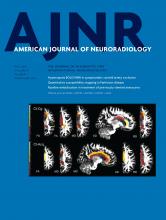With great interest, I read the recent article by Inoue et al1 on the diagnostic significance of cortical superficial siderosis (cSS) for Alzheimer disease in a memory clinic setting. In line with other recent studies on the topic, the authors found cSS in 12 of 347 (3.5%) patients in the memory clinic, a prevalence much lower compared with pathologically proved cerebral amyloid angiopathy (CAA) (approximately 50%), but still higher than the 1% prevalence seen in population-based studies. Not surprisingly, in the current study, cSS was found to be associated with strictly lobar microbleeds,1 a putative marker of CAA.
In a letter to the editor about this study, Bai et al2 raised a number of important points on cSS definition and detection and opined that the pathogenesis of cSS in the context of CAA is still an unproven hypothesis. They suggested that an, as yet, unidentified bleeding source may account for cSS in the studied cohort instead of CAA.2 Some of these issues deserve further attention. First, ample evidence suggests that cSS detected in older patients (generally older than 50 years of age) in the context of small-vessel disease (including CAA) is quite distinct from the “classic” superficial siderosis of the central nervous system with regard to underlying pathology, pattern, and clinical presentation.3 The classic superficial siderosis of the central nervous system (to which Bai et al are referring), affects mainly the infratentorial regions (brain stem and posterior fossa) and spinal cord and typically presents with progressive sensorineural hearing loss, cerebellar ataxia, and corticospinal tract signs.3 By contrast, published CAA cases with cSS lack these typical clinical manifestations, and cSS is limited to the supratentorial compartment over the convexities of the cerebral hemispheres (almost always sparing the brain stem, cerebellum, and spinal cord).4,5 It is possible the use of the term “siderosis” for both entities is contributing to this confusion.
While I completely agree with Bai et al2 that cSS has a wide variety of potential causes, in older individuals, it is emerging as a key neuroimaging signature of CAA. In fact, revised diagnostic criteria for CAA include cSS as an additional hemorrhagic manifestation of the disease, equivalent to lobar cerebral microbleeds and intracerebral hemorrhage.4 The exact pathophysiologic mechanisms of the association between cSS and CAA remain an active field of research. However, the role of CAA-related microangiopathic disease as an important cause of cSS in the elderly needs to be emphasized; the most biologically plausible hypotheses based on available evidence are extensively discussed in a recent expert review.5
Some technical issues on cSS detection and evaluation are also mentioned by Bai et al2 in their letter. Most important, differentiating cSS from cortical microbleeds is not difficult if operational criteria are applied because the 2 lesions have different size ranges and shapes on T2*-weighted gradient-echo or susceptibility-weighted imaging sequences. cSS shows curvilinear signal intensity in the superficial layers of the cerebral cortex, within the subarachnoid space, or in both, whereas microbleeds are small (generally 2–5 mm), well-defined, homogeneous, and either round or oval lesions.6 In addition, at least half of the microbleed lesion should be surrounded by brain parenchyma—unlike cSS. The differentiation of microbleeds and cSS becomes more challenging when (rarely) multiple microbleeds are located very near the cortical surface, creating “microbleeds pearls.” In this scenario, the systematic application of operational criteria is essential. Hence, Bai et al touch on a key methodologic aspect in small-vessel disease imaging marker research, namely the use of consistent imaging criteria and standards for evaluating and reporting cSS in relevant studies in the field. To facilitate this, we have recently suggested definitions and minimum imaging standards for cSS evaluation5—a slightly modified version of these is provided in the Table. Further studies on the sensitivity and specificity of cSS as a diagnostic MR imaging marker of CAA are necessary.
Updated minimum criteria for identification of cortical superficial siderosis and acute convexity subarachnoid hemorrhage in the context of CAA and small-vessel disease5
References
- © 2016 by American Journal of Neuroradiology












